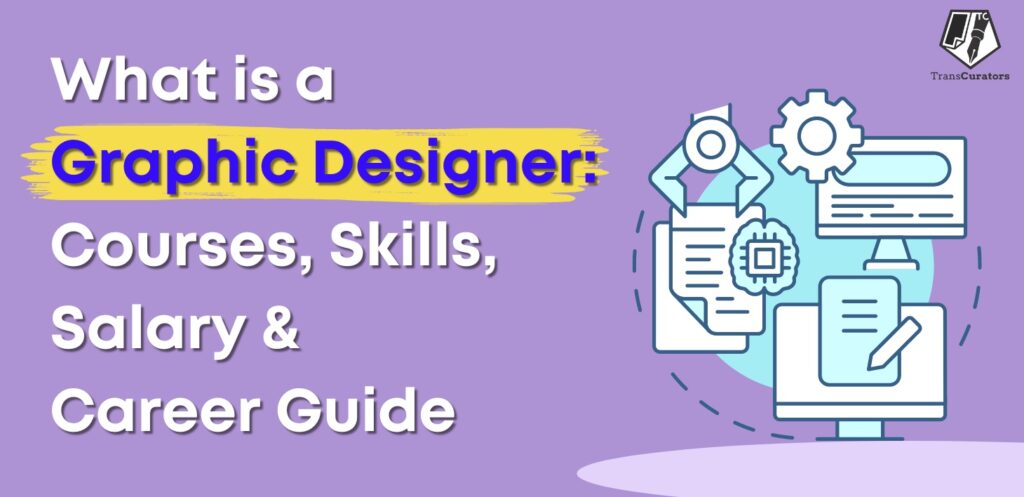
Graphic design plays a crucial role in our visually oriented-environment. You can see graphic designers’ work wherever you turn, from websites and commercials to product packaging and branding. They use their creativity and technical skills to communicate messages in visually appealing ways. So, if you’re passionate about design and have a keen eye for aesthetics, a career in graphic design could be the perfect fit for you, and knowing the educational paths, essential skills, possible compensation, and career prospects can help you make an informed decision. Let’s delve into what it takes to become a graphic designer.
What is a Graphic Designer?
A creative professional graphic designer creates visual designs using computer software or by hand. They use art and technology to convey ideas through images and layouts. These experts work on various projects, including logos, websites, posters, and packaging. Graphic designers play an important role in branding and marketing, ensuring that messages are heard and understood. They have a keen eye for detail, a talent for creativity, and a solid grasp of colour, typography, and layout. Graphic design is classified into multiple types, each serving a specific function and industry. Branding and logo design aims for visual identities that represent businesses and goods. Web and app design includes developing user interfaces and experiences that are both functional and visually appealing. Print design includes traditional media such as brochures, posters, and magazines, guaranteeing efficient communication through physical formats. Packaging design enhances the product’s appearance and information using innovative and practical packaging options. Finally, motion graphics bring elements to life through animation, which improves video content and digital presentations. Each type of graphic design needs a unique skill set and understanding of its specific medium to effectively communicate messages and engage audiences.
In a nutshell, graphic designers create eye-catching pictures that successfully express messages. Whether a stylish logo for a new business or a spectacular billboard for a product, graphic designers ensure it looks excellent and conveys its intended message.
What are the Required Skills for Graphic Designers?
To become a successful graphic designer, you must possess a combination of creativity, technical skills, and business acumen. These skills enable you to build visually appealing designs and communicate messages effectively. Here are some essential skills every graphic designer should have:
1. Creativity
Graphic design relies primarily on creativity. It is better to come up with new, fascinating concepts that will attract people’s attention. Whether creating a logo, website, or brochure, you should enjoy exploring innovative ideas and think creatively. Creativity helps you to bring your clients’ visions to life in a unique way.
2. Typography
Typography is the process of organising text to be readable and visually appealing. As a graphic designer, you need to understand the different fonts and how to apply them effectively. You should know how to choose fonts that complement the tone and message of the design. Good typography makes your text readable and aesthetically pleasing.
3. Colour Theory
Colours carry a significant role in the design. You must understand how colours interplay and how they can bring up different emotions. Colour theory helps you build balanced colour schemes and make informed decisions about colours for your projects. For example, implementing the proper colour combinations can make a design attractive while communicating the intended idea more effectively.
4. Software Proficiency
Mastering design software is critical for graphic designers. You must be proficient with Adobe Photoshop, Illustrator, and InDesign tools. These programmes are industry standard and have several features to assist you in creating professional designs. Knowing how to use these tools efficiently allows you to bring your artistic concepts to life.
5. Attention to Detail
Details hold significance in graphic design. Alignment, spacing, and uniformity are small details that greatly influence the design. You have to be very mindful of these aspects if you want your designs to appear polished and professional. Attention to Detail helps you to produce error-free, excellent work that satisfies client expectations.
6. Communication Skills
For graphic designers, effective communication is essential. You need to convey your ideas clearly to clients and team members. You can communicate your design choices more effectively and comprehend client feedback with strong verbal and written communication skills. This guarantees that you and your client are on the same page and can work together to get the desired results.
7. Time Management
Often, graphic designers work on multiple projects simultaneously, each with a deadline. Good time management skills help you to manage these tasks well. Prioritise your tasks, use time management techniques, and fulfil deadlines without affecting the quality of your designs. This skill is crucial for sustaining a consistent workflow and satisfying clients.
8. Problem-Solving
Graphic design projects often encounter challenges. It would be greatly beneficial if you could find creative solutions quickly, whether it was a design issue or a specific client requirement. Problem-solving skills allow you to think critically and overcome challenges. This ability to adapt and resolve issues helps you deliver successful projects even when faced with difficulties.
9. Marketing Knowledge
A basic grasp of marketing can improve your design work. Understanding how to attract and engage your target audience helps you to craft visually appealing designs that successfully convey the intended message. Marketing expertise assists you in aligning your designs with business goals and producing work that delivers results.
10. Adaptability
The design industry continually evolves, with new trends and technology surfacing regularly. As a graphic designer, you have to keep up with the latest trends and be prepared to adapt your style and techniques. Being willing to learn and experiment with new concepts lets you stay up-to-date in the business while keeping your work fresh and distinctive.
11. Collaboration
Working as a graphic designer often calls for collaboration with other designers, advertisers, and clients. Good teamwork skills are necessary. To get the best results, you need to be willing to listen to others, share your ideas, and cooperate. Effective collaboration lets you capitalise on different perspectives and skills to enhance your designs.
12. Business Acumen
Understanding the business-related aspect of graphic design can help you set apart. This entails having effective pricing strategies, managing client relationship abilities, and self-marketing knowledge. Business acumen can help you operate a successful freelancing business or provide significant insights if you work for a company.
Becoming a graphic designer necessitates a combination of artistic skill, expertise in technology, and practical knowledge. Developing these skills enables you to produce visually appealing designs that successfully convey messages and meet client needs. With dedication and continuous learning, you can be successful in the dynamic and amazing field of graphic design.
What is a graphic designer’s salary?
A graphic designer’s salary can vary depending on experience, location, industry, and skills. Here’s a breakdown of what you can expect to earn as a graphic designer at different stages of your career in India:
Entry Level to Senior Level:
As a beginner, you will likely work on basic design tasks and progressively develop your skills and portfolio. Your salaries can also be determined by the size and type of the company you join. You can expect to earn an annual salary varying from ₹2,00,000 to ₹3,50,000. Your salary will increase following a few years of experience—typically three to five years. In India, graphic designers at the mid-level earn between ₹4,00,000 and ₹7,00,000 annually. At this stage, you will be managing more complex projects and may have more responsibilities, justifying the increased salary. Senior graphic designers with several years of experience and a strong portfolio can earn higher salaries. Senior designers make an average of ₹8,00,000 to ₹12,00,000 yearly. If you advance into a leadership position, such as an art director or creative director, you may earn more than ₹15,000,000 a year. These positions involve managing a design team and leading larger projects.
Freelance Graphic Designer:
Graphic designers can also work as freelancers. As a freelance graphic designer, your earnings can vary greatly depending on the clients you serve, the rates you charge, and your work. Freelancers usually charge by hour or project. Hourly prices can range from ₹500 to ₹2,500, based on experience and project complexity. Full-time freelancers with steady clients can earn ₹3,000,000 to ₹10,000,000 or even higher annually.
Why Should You Consider Graphic Design as a Career?
Choosing a profession in graphic design offers a mix of creativity, flexibility, and rewarding opportunities. You get to work on various projects, showcase your creative skills, and grow yourself constantly. Graphic design is a promising and fulfilling career choice because of its high demand and earning potential. Here are a few compelling reasons for considering a career as a graphic designer.
1. Creative Freedom
As a graphic designer, you get to express your creativity every day. You can work on different projects, including logo design, web design, marketing materials and social media graphics. The steady flow of fresh assignments makes the job interesting and exciting. You get to bring your unique concepts to life and see them make a significant impact.
2. High Demand
The demand for graphic designers is quite great in the current digital era. Skilled designers are critical for businesses in various industries to produce captivating graphics for their brands. Businesses are always looking for excellent graphic designers, whether it’s for website design, social media, product packaging, or advertising. This demand offers job security and multiple growth opportunities.
3. Versatile Career Paths
There are many various career paths in graphic design. You can work in multiple industries, including marketing, publishing, entertainment, and advertising. Additionally, you can specialise in web design, branding, animation, UX/UI design, or other related fields. This freedom enables you to tailor your career to your interests and strengths.
4. Flexibility
A lot of graphic designers enjoy flexible schedules. You can establish your design firm, work as a freelancer or find full-time employment at a company. Freelancing allows you to choose your projects, create your schedule, and work from anywhere. This flexibility is perfect for you if you want to work remotely or prefer a work-life balance.
5. Continuous Learning
Graphic design is a constantly evolving profession. New tools, trends, and technology are continually emerging, keeping the workplace dynamic. As a graphic designer, you will continuously learn and adapt. This continuous growth keeps your skills sharp and prevents the job from becoming monotonous. You can try new techniques and stay at the forefront of design innovation.
6. Collaboration Opportunities
Graphic designers often collaborate with other creative professionals, such as authors, marketers, and developers. This collaborative setting promotes learning and inspiration. You get to exchange ideas and work on big projects requiring various skills. Working in a team can also help you improve your problem-solving skills and expand your professional network.
7. Good Earning Potential
Graphic design has great earnings potential. As your experience and portfolio expand, you can expect to charge better pay and freelancing rates. Specialised talents and knowledge in high-demand fields, such as UX/UI design, can increase your income. You can achieve financial stability and growth in this career with commitment and continual improvement.
8. Global Opportunities
Graphic design skills are in high demand worldwide. This global demand allows you to venture beyond your market. You can grow your knowledge and perspective with international clients or businesses. This worldwide access can also lead to exciting travel opportunities and the possibility to engage in varied and culturally rich projects.
How to become a graphic designer?
Becoming a graphic designer involves a few key steps. Here’s a simple guide to help you on your journey:
1. Learn the Basics
Begin by learning what graphic design is all about. Explore several fields, such as online design, branding, and print design. Study basic design ideas, including colour theory, typography, and layout. Many resources are available online, including articles, videos, and tutorials.
2. Get Educated
Consider enrolling in a graphic design programme at a college or university. A formal education can give a strong foundation and practical experience. If you cannot attend a regular programme, consider taking online classes through Coursera, Udemy, or Skillshare. These courses will provide you with the basic skills you require.
3. Learn Design Software
Master the tools of the trade. Concentrate on industry-standard applications such as Adobe Photoshop, Illustrator, and InDesign. Several online tutorials and courses are available to assist you in mastering these programmes. As you develop, look at additional programmes such as Sketch, Figma, or Affinity Designer, particularly if you’re interested in online or app design.
4. Build a Portfolio
Build a portfolio showcasing your finest works. To create a varied collection, start with small or personal projects. Add various items, including social media images, posters, websites, and logos. Update your portfolio regularly as you accomplish new projects.
5. Gain Experience
Look for ways to obtain practical experience. Apply for internships, do freelance work, or volunteer for projects. Working with real clients enables you to understand project requirements, timeframes, and client feedback more effectively. This experience is critical for improving your skills and confidence.
6. Network with Other Designers
Engage with other graphic designers to explore new opportunities and gain assistance. Join design networks, attend industry events, and contribute to online forums. Networking allows you to gain insight from others, ask for feedback on your work, and stay current on industry trends.
7. Stay Updated with Trends
Follow social media, subscribe to trade periodicals, and follow design blogs. Keeping up with current trends and technology is essential to maintain the relevance of your skills in the ever-evolving design industry. Continuous learning guarantees that your designs remain fresh and trendy.
8. Create an Online Presence
Create a professional online portfolio or website to display your work. Share your designs and connect with possible clients or companies using networks such as Behance, Dribble, or LinkedIn. A strong online presence helps you to reach a larger audience.
9. Apply for Jobs or Start Freelancing
Apply for graphic design jobs when you feel confident about your skills and have a strong portfolio. Customise your resume and portfolio for each application, emphasising relevant skills and prior experience. Alternatively, you can start freelancing by offering services on networks such as Upwork or Fiverr.
10. Keep Improving
The field of graphic design constitutes a form of continuous learning. Continue to hone your talents by taking advanced classes, experimenting with various styles, and working on diverse projects. The more you learn and practice, the better you become.
Conclusion
A graphic design career is fulfilling and dynamic, combining creativity and technology. Aspiring graphic designers can explore multiple opportunities in various fields by pursuing the appropriate educational pathways, developing important skills, and staying current on industry trends. Potential job options are diverse and exciting, from branding and web design to UX and motion graphics. Knowing what to anticipate from salary and how to grow in your work can guide your journey. Whether you work as a freelancer, in-house, or advance to leadership roles, graphic design is a rewarding and ever-evolving career. Ready to take the next step in your graphic design career? Visit TransCurators for expert guidance and valuable resources tailored to aspiring and professional graphic designers. Start creating your future today with TransCurators!
Frequently Asked Questions
A1. A degree in graphic design or a related field is common, but many successful designers are self-taught or have completed specialised courses.
A2. Proficiency in Adobe Creative Suite (Photoshop, Illustrator, InDesign) and tools like Sketch and Figma is essential.
A3. Career paths include branding designer, web designer, UI/UX designer, illustrator, motion graphics designer, and art director.
A4. Certification is not mandatory but can enhance your skills and credibility. Many designers pursue certifications in specific software or design techniques.
A5. Key trends include an emphasis on user experience, sustainable design practices, the integration of AI, and the rise of virtual and augmented reality.



